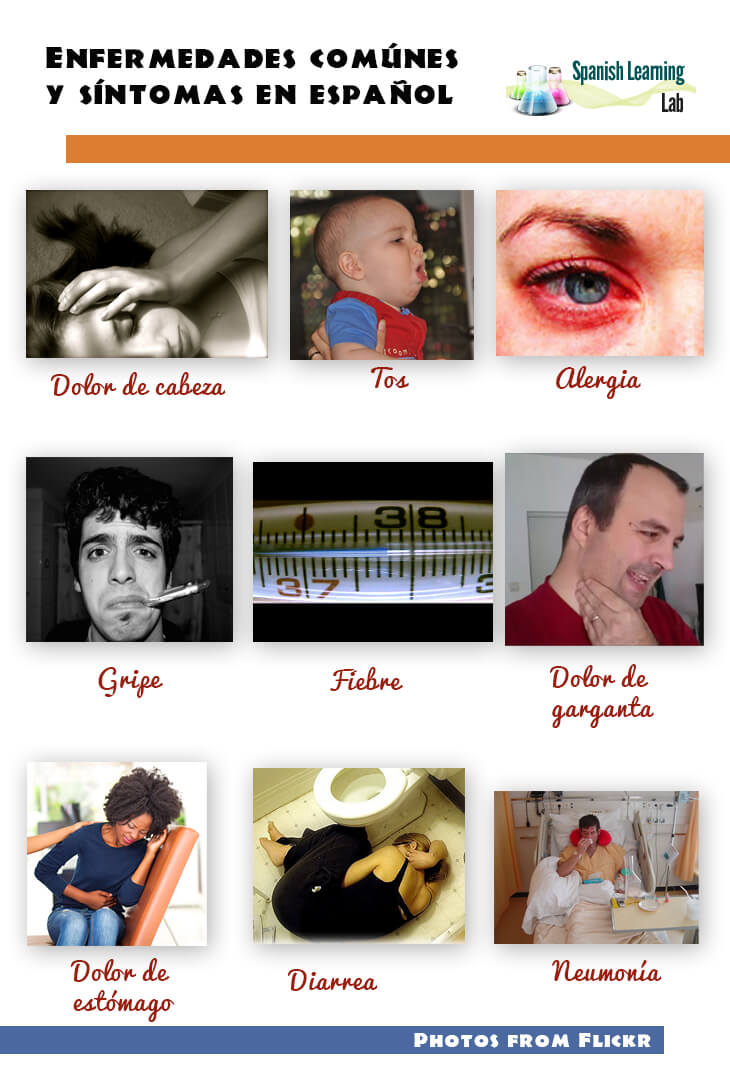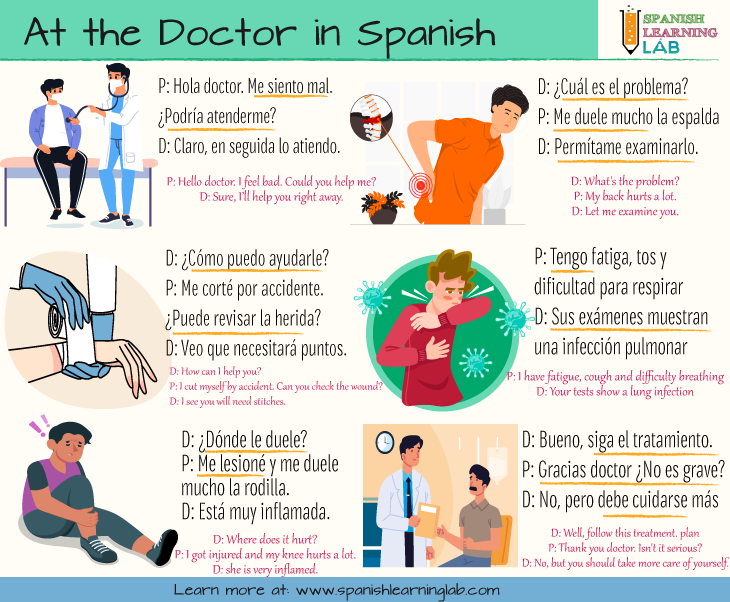¡Hola! Today’s lesson will cover some very useful phrases and questions for having a basic doctor and patient conversation in Spanish. To do so, we have included the names of some common illnesses and symptoms in Spanish, as well as two listening activities and examples resembling real visits to the doctor in Spanish. Let’s start…
Vocabulary Introduction: A list of Common illnesses in Spanish
First, please take a look at the picture showing the names of some common symptoms and illnesses in Spanish. As you may notice, some of them are very similar in both languages, while others are totally different. You may listen to the pronunciation of these words in the podcast below the image.

Interactive quiz No. 1
Look at these vocabulary cards and write the names of these symptoms or illnesses in Spanish, then check your answers.
náuseas / dolor de estómago / una cortadura / una fractura / problemas del corazón / cáncer / fatiga / dolor de espalda / tos / problemas de la piel / hipertensión / obesidad / fiebre / dolor de garganta / diarrea / diabetes / asma / alergias
Some useful questions and phrases at the doctor in Spanish
Explaining “what’s the matter” in Spanish
During a visit to the doctor, he/she will probably ask you one of the following questions:
- ¿Cómo te sientes? (How are you feeling?)
- ¿Cuál es el problema? (What’s the matter?)
- ¿Cómo puedo ayudarte? (How can I help you?)
In order to reply, we will generally use the phrases “Me siento con + síntoma” or “Tengo + síntoma”, for example:
- Me siento mal. (I feel bad)
- Me siento cansado (I feel tired)
- Tengo fiebre (I have a fever)
- Yo tengo un fuerte dolor de cabeza. (I have a very strong headache.)
Since being sick is a state, we will also need the irregular verb ESTAR, to talk about temporary conditions such as illnesses, to be able to explain our current state, and to discuss symptoms, as illustrated in these examples:
- Yo estoy enfermo. (I am sick.)
- Él está con náuseas. (He is feeling nauseous.)
- Ellos están con dolor de estómago. (They have a stomach ache.)
Saying “It hurts” in Spanish
First, the stem-changing verb DOLER will be used to indicate where people feel pain, for example:
- Me duele el pecho. (I have chest pain)
- A mí me duele un poco el brazo. (My arm hurts a little.)
- ¿Te duele cuando mueves la pierna? (Does it hurt when you move your leg?)
- ¿Dónde le duele? (Where does it hurt?)
We will also use the phrase “Dolor de + a part of the body” to tell where we feel pain. A variation of this phrase would be “Dolor en …” as in “Dolor en la espalda” and “Dolor en el pecho”. Unlike English, Spanish does not have a word for the suffix “-ache” so it will always be translated as “DOLOR”(pain). Pay attention to these examples:
- Yo tengo dolor de espalda. (I have back pain.)
- Yo siento dolor en el hombro. (I have pain in my shoulder.)
- Ella tiene un dolor de muelas insoportable. (She has an unbearable toothache.)

Common questions and phrases in a doctor and patient conversation in Spanish
Listen to some examples using some of these essential expressions and questions for conversations between doctors and patients in Spanish.
|
¿Cuál es el problema? – Me duele el pecho
What’s the matter? My chest hurts
|
|
¿Cómo te sientes? – Tengo dolor de estómago
How you feel? – I have a stomachache
|
|
¿Dónde te duele? – Me duele la cabeza
Where does it hurt? – I have a headache
|
|
¿En qué puedo ayudarle? – He estado con fiebre los últimos tres días.
How can I help you? – I’ve been feverish for the past three days.
|
|
¿Qué puedo hacer por usted? – Doctor, he estado con dolor de cabeza desde ayer.
What can I do for you? – Doctor, I’ve been with a headache since yesterday.
|
| ¿Se ha sentido mareado? – Sí, me he sentido un poco mareado. Have you felt dizzy? – Yes, I have felt a little dizzy. |
| ¿Ha estado con gripe? – Sí, tuve gripe hace una semana. Have you had the flu? – Yeah, I got the flu about a week ago. |
|
¿Tienes dolor en la garganta? – No, no me duele la garganta.
Do you have a sore throat? – No, I don’t.
|
| ¿Qué ha comido recientemente? – Solamente algo que compré en la calle. What have you eaten recently? – Just something I bought on the street. |
| ¿Eres alérgico a algo? – Sí, soy alérgico al maní. Are you allergic? – Yeah, I’m allergic to peanuts. |
Interactive quiz No. 2
Complete these short dialogues about visits to the doctor in Spanish by dragging the words to the correct spaces.
The basics about the present perfect in Spanish
The present perfect in Spanish can be a really useful tense when having a doctor – patient conversation in Spanish. It is really helpful to say the symptoms you have experienced and explain why you may feel sick. Sentences in this tense are formed by using the verb HABER plus a verb in past participle (estado, comido, viajado, etc.). Basically, HABER will be conjugated like this for the present tense in Spanish:
- Yo he estado enfermo. (I have been sick.)
- Tú has estado con fiebre. (You have had a fever.)
- Él/Ella/Usted ha estado con gripe. (He/She/You has had the flu.)
- Nosotros hemos tenido calambres. (We have had cramps.)
- Ellos/Ustedes han sentido mareos. (They/You have experienced dizziness.)
This way, when talking about symptoms and illnesses in Spanish, the present perfect in Spanish will help you tell what you have felt or how you have been recently:
- “He sentido + un síntoma” (I have felt…),
- “He tenido + un síntoma” (I have had…),
- “He tomado + algo” (I have taken…)
- “He comido + algo” (I have eaten…)
- “He estado con + un síntoma” (I have been…)
Listening Activity No. 1: A visit to the doctor in Spanish
Key phrases in the conversation:
- “No me he sentido muy bien”, means “I haven’t felt well lately”
- “Un poco”, means “a little…”
- “¿Ha tenido + síntoma?”, means “Have you had + a symptom?”
Listening Activity No. 2: Receiving medical attention in Spanish
Key questions in the conversation:
- “¿Hace cuánto tiene este problema?”, means “how long have you had this problem?”
- “¿Le duele si…?”, means “Does it hurt if…?”
- “¿Qué tratamiento debería seguir?“, means “What treatment should I follow?”
Related PDF worksheets:
- Parts of the Body in Spanish – Crossword Puzzle
- The Vocabulary for Illnesses in Spanish
- Let’s talk about Health in Spanish – Conversation cards
- At the Hospital in Spanish (Key Vocabulary)
- Medical Breakthroughs in Spanish (Reading)
- Describing Lifestyles in Spanish (Reading)
- Body Parts in Spanish (Vocabulary)
